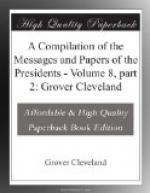It was in this view and in strict conformity with the Constitution conferring the treaty power that the President on the 7th December, 1831, submitted to the Senate this “award” and “advice” of the King of the Netherlands. Senators were divided on a principal point, some insisting that to carry the award or opinion into effect was only in execution of the treaty, and it therefore belonged exclusively to the President “to take care” that this “supreme law” was faithfully executed or to reject it altogether.
But the prevailing opinion was that this “award” or “advice” was perfecting an unfinished treaty, and that therefore it could not be effected by the President without “the advice and consent of the Senate, two-thirds of the members present concurring therein.” So far from the concurrence of two-thirds for the measure, there were thirty-four to eight against it, and it was consequently rejected, and a recommendation to the President was adopted to open a new negotiation to determine the line of boundary according to the treaty of 1783.
It is insisted by the British ministers that a due north line from the monument at the source of the St. Croix will intersect no highlands described in the treaty of 1783. Now this is an assumption by Great Britain totally unwarranted by any evidence. The boundaries bearing upon the question are thus given: “From the northwest angle of Nova Scotia, to wit, that angle which is formed by a line drawn due north from the source of the St. Croix River to the highlands; along the said highlands which divide the rivers that empty themselves into the St. Lawrence from those which fall into the Atlantic Ocean, to the north westernmost head of Connecticut River”; “east by a line to be drawn along the middle of the river St. Croix from its mouth, in the Bay of Fundy, to its source, and from its source directly north to the aforesaid highlands which divide the rivers that fall into the Atlantic Ocean from those which fall into the St. Lawrence.”




